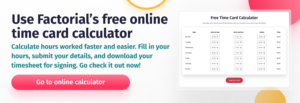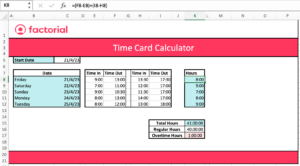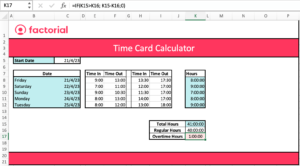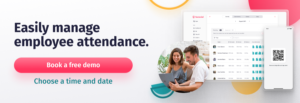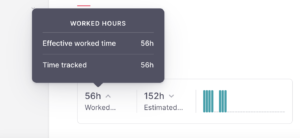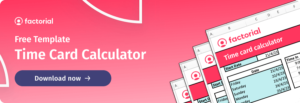A time card calculator is a basic time clock spreadsheet for logging employee hours worked. It will help you keep track of hours worked in order to simplify HR processes and payroll. With this template, you can calculate and fill timesheets, avoid payroll mistakes, ensure all employees are working the correct hours, and ensure that employees get paid for the correct hours worked.
Read on for walkthrough on how to create your own calculator in Excel, as well as answers to any questions you may have on using this template.
TABLE OF CONTENTS
Timesheet Calculator Excel Tutorial
The difference between time cards and timesheets
Why use time card calculators?
Factorial vs. Excel as Work Time Calculator
Time Tracking Features
Choosing a timesheet calculator for your company
Clock in software ✅
Timesheet Calculator Excel Tutorial
This example teaches you how to create a simple timesheet calculator in Excel. If you want to save time, just skip to the end of this article to download your free time card calculator excel template.
How to create a Time Card Spreadsheet in Excel
1. Automating work days and dates:
To automatically calculate the next 4 workdays and corresponding dates when you enter a start date in the top-right corner, use the following formula:

2. Select the cells containing the total hours worked per day:
3. Choosing the correct time format:
Right click, click Format Cells, and select the right Time format. Use the highlighted format seen in the image below for cell K15, K16 and K17. Click OK.
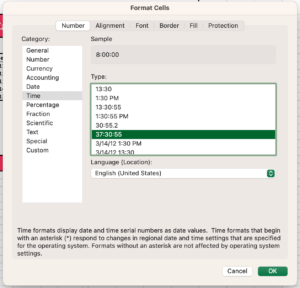
4. To automatically calculate the hours worked each day use the formula below:
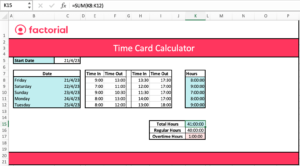
5. To automatically calculate overtime hours use the formula below:
Congratulations, you’ve created your very own timesheet calculator!
Factorial vs. Excel as Work Time Calculator
We’ve collected some of the features and benefits of both to help you choose the best option for your company.
Factorial: Streamlined Time Tracking and HR Management
Factorial is a dedicated time tracking and human resources management platform. It offers a comprehensive suite of features designed to streamline employee time monitoring and overall HR processes.
Here’s what Factorial brings to the table:
Automated Tracking: Factorial automates time tracking, enabling employees to log their hours easily. This minimizes manual data entry, reducing the risk of errors.
Efficient Reporting: The platform generates detailed reports and analytics, providing insights into employee work hours, overtime, and attendance patterns.
Integration: Factorial integrates with various tools, facilitating seamless data exchange between different HR and project management systems.
Task and Project Allocation: Assigning tasks and projects to employees is simplified, helping managers allocate resources effectively.
Compliance: Factorial ensures compliance with labor regulations and helps manage leave requests, holidays, and employee documentation.
And now let’s take a look at what Excel spreadsheets have to offer.
Excel: Versatile, Manual Time Tracking
Excel, on the other hand, is a versatile spreadsheet software widely used for various purposes, including time tracking.
Here’s how Excel compares:
Customization: Excel allows you to create customized time tracking templates tailored to your specific requirements.
Flexibility: You have control over formulas and formatting, making it possible to adapt the spreadsheet to changing needs.
Learning Curve: Excel requires a certain level of proficiency to set up and maintain, which might necessitate training for some users.
Limited Automation: While Excel can handle basic calculations, automation is limited compared to dedicated time tracking software like Factorial.
Scalability: As your organization grows, maintaining a complex time tracking system in Excel may become more cumbersome.
Time Tracking Features
Factorial serves as a comprehensive time tracking solution that goes beyond basic clock-in and clock-out features. By automating and centralizing time-related data, providing insightful reports, and integrating seamlessly with other HR processes, Factorial empowers businesses to optimize their time tracking efforts, enhance employee productivity, and ensure accurate compensation.
Factorial not only helps with time tracking, but also with PTO request approval, shift management, and more.
Let’s take a look at some of Factorial’s features related to time:
1. Centralized time tracking hub
Factorial collects all of your time tracking tools in a single hub, which means you don’t have to go searching for the correct Excel file every time you want to make a change to a timesheet. You can see hours and minutes worked, estimated time remaining, work location, and other metrics.
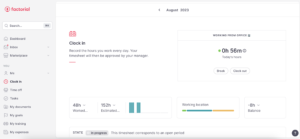
2. Clock in app
Employees can download the Factorial app to their own device, and they can then essentially use it as a time clock. Employees can scan a QR code in the office when they want to clock in. Managers receive emails with notifications about clock in times and employees can also be asked to sign timesheets electronically.
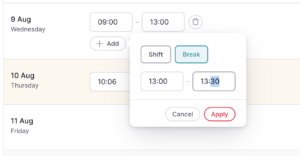
3. Automatic time calculation
Software like Factorial allows you calculate time worked completely automatically, without even the need for the click of a mouse. Simply log the work hours consistently and watch as the hours accumulate.
Choosing a timesheet calculator for your company
Choosing between Factorial and Excel depends on factors such as your organization’s size, complexity, and the level of automation you require. Factorial offers a comprehensive solution with automated features, well-suited for businesses looking for an integrated HR and time tracking solution. Excel, while versatile, may be more suitable for very small businesses with simpler time tracking needs and a willingness to manage and customize their own spreadsheets.
In conclusion, evaluating your organization’s requirements and the features offered by Factorial and Excel will help you make an informed decision on the most suitable time tracking solution.
